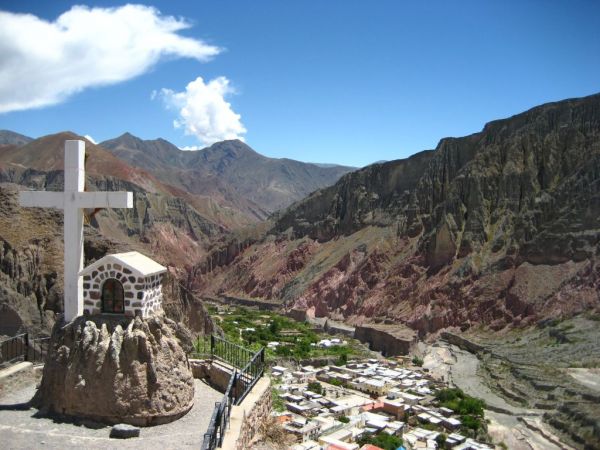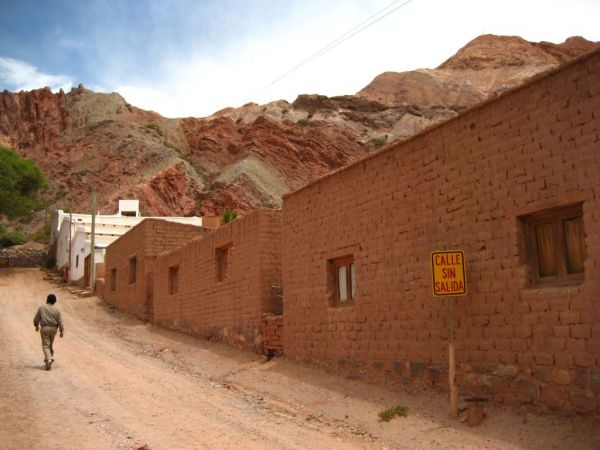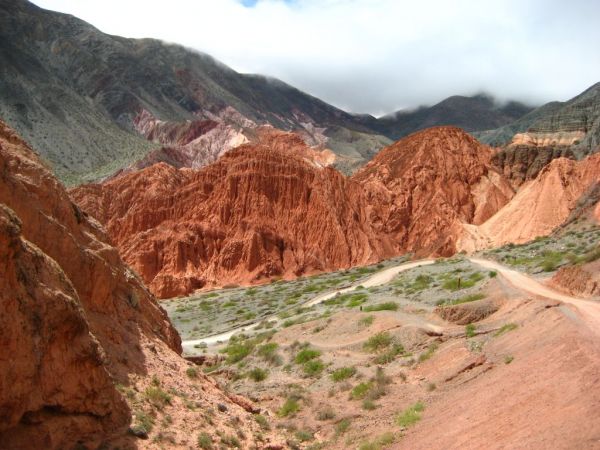Change of scenery, I leave this area of Argentina, bordering Brazil and Paraguay to go to the Andean northeast. After a stop in the city of Salta, I head for the Humahuaca quebrada where a set of tiny villages stretch out along the canyon. The Argentinians who lives in these lands have much more similarities with their Bolivian neighbours than with the distant porteños (inhabitants of Buenos Aires). The quebrada-built-in asphalted road leads me up to the village of Humahuaca. The dusty alleyways weave in and out of the whitewashed buildings. I live in the Posada El Sol hostel, an architecture jewel, simple and local, nestled in the bottom of the village. The overhead colourful hill overlooks the village. A heaven to rest or to immerse oneself in the Andean culture.















The next day, departure for the village of Iruya through a bumpy, earthy road. We cross a 4000m-plus pass. We are geographically at the beginning of the Altiplano, this high Andean plateau that towers between 3000 and 5000m high. The village stands in the only flat corner of the canyon. All the rest is only stone-draped hill and dried riverbed. A promontory-topping shrine and a white cross enlighten and protect the villagers. The time seems to stop and the daily public bus is the only link with the other southern villages.















Tilcara and Purmamarca complete the list of the villages of this valley. While the first one entices the Andean-craft-lovers tourists, the second one nestles in the spurs of the seven-color hill. A path goes up and down behind the village. I plunge into the earth and stone rainbow which covers the hillocks of the route. The night, zampoñas, sikus and guitar propagate the melodious waves of the Andean music in one of the restaurants of the village. The music is gut-wrenching. I walk out the restaurant, the music keeps on resounding inside my head ; my feet lift up the dust of the church-lined alleyways in the silence of a soft night. It's hard to think that in one week I'll set foot on the big malls among the crowd, two days before Christmas.









Before definitely leaving the quebrada, a small local travel agency offers an excursion to las salinas grandes. A miniature replica of its Bolivian neighbour, the salar of Uyuni. A flat, white expanse stands out with the tormented sides of the quebrada, salt in abundance cracks under our steps. A white desert whose salt is partly exploited to end in a box, laid on a table.









Keyword - resting -
Saturday 15 December 2007
the palette of colors of the Humahuaca quebrada
By dorian on Saturday 15 December 2007, 10:03 - RTW-Argentina
Thursday 25 October 2007
Paradisiac beaches on the Koh Phi Phi island
By dorian on Thursday 25 October 2007, 22:35 - RTW-Thailand
Steep rocky walls that a green and lush nature trickles over. Strips of sand gnaw the rock to form superb bays. The island of Koh Phi phi is actully composed of 2 islands : Phi Phi Don and Phi Phi Leh.
Phi Phi Don is characterized by 2 crescents of sand linking the two headlands of the island which shape a big "X" within the blue immensity. As for Phi Phi Leh, it's a protected area and it's impossible to stay and sleep on. It harbours some grottoes swallows get in to build their nest, a nest they make with their saliva. Climbing bamboo ladders, a few life-risking villagers go to pick them. These nests are famous for their aphrodisiac powers and are an ingredient of Chinese soups. At 2500 euros a kilo, these nests are considered as national treasure and the grottoes entrances are guarded. Phi Phi Leh is also famous to be the scenery of the movie "the beach" and full of scuba diving and snorkelling spots dot the coastline.





























The sea bed gives the gorgeous beaches their cue. Funnel-shaped corals and red gorgones spread out and extend the rock while anemones and giant clams attempt to cling to. Seaweeds and mosses struggle to occupy the last free parcels of rock. Soft corals dance according to the currents and hide throngs of angel- and butterfly-fish. Close to the surface, the trumpet-fish wanders about alone while near the bottom, the struggle is fierce for some crumbs of corals.
The parrot-fish shatters the coral and the clown-fish frantically swims among the anemones. Within the chinks of the rock, porcupine- and box-fish clumsily move about. Turtles, black-tip sharks and lion-fish complete this submarine watercolour.
Everyday, the same ritual which turns into a deep pleasure : fixing the mask and going underwater to discover the submarine kingdom. An intoxicating kingdom we fall in love a little bit more after each dive.



















































































Friday 19 October 2007
From the Khao San Road in Bangkok
By dorian on Friday 19 October 2007, 00:03 - RTW-Thailand
What a pleasure to burst in on the Khao San Road, heaven for backpackers of every kind. Even if some people will prefer other less noisy and less colourful streets. That's here, a few years ago, I started my first trip with a rucksack and I fell in love with this way of life. This fantastic sensation of feeling a total freedom on the route, choosing a hostel for its style or its location and not because we have to. And Thailand is such an easy country to travel in that it was and still remains the perfect destination for a first nomadic trip. Even if the Thailand's ease of access and low-cost prices bring some disadvantages, beginning with the mass tourism which spoils a lot of places. We loose the serenity of the beautiful sand beaches we like to walk on, the feet into the water.



I meet Armelle after more than 2 months and it started to be long. We go for a stroll onto the Thonburi canals. Departure from the Chao Phraya bank by long-tail boat. A slender, colourful boat, powerfully propelled by a truck engine and terribly noisy, snakes onto the narrow canals. Houses on stilts and aquatic plants square the twists of this district off that locks protect from the Chao Phraya flood.







Before going back to the bank we started from 2 hours before, we visit the Wat Arun.




As we get back, we stop at the Wat Pho whose temple harbours a gigantic Buddha that lyes on his right side. Innumerable leaves of gold wholly cover the lying statue. We go round the gilded colossus and a row of metallic bowls resonate with the falls of coins followers throw in each one of them.






The architecture of the religious and official buildings has the distinctive feature of being tremendously wrought and ornated with vivid colours. Most of the buildings are wholly or partially decorated with these leaves of gold ; the sunbeams ricochet off and splash us. That's the way the Wat Phra Kaeo, king's palace, gives out its multi-hued, shining beams in the central district of Bangkok and attracts a crowd of tourists eager for oriental curiosities.












« previous entries - page 4 of 7 - next entries »





 visits
visits